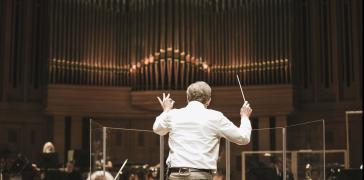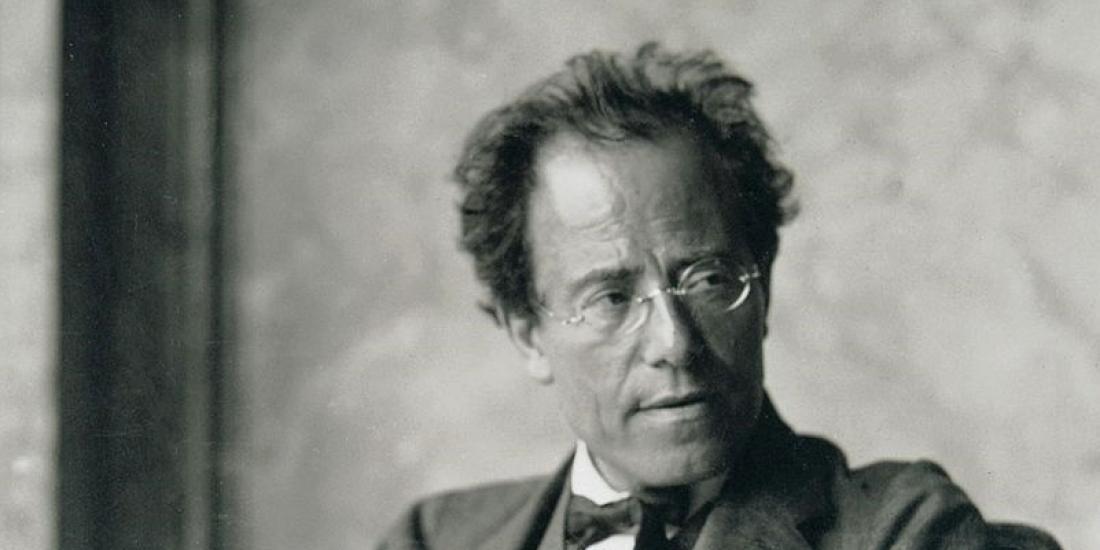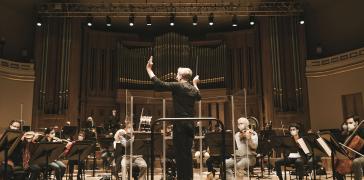
Mahler Cycle

The three federal cultural institutions - La Monnaie, Bozar and the Belgian National Orchestra - are joining forces to offer the complete symphonies of Gustav Mahler spread on two seasons. This season, you can already (re)discover the First, Second, Fifth and Sixth Symphonies! The programme also includes Mahler's Lieder eines fahrenden Gesellen.
Mahler 1, 'Titan' (Belgian National Orchestra & Roberto González-Monjas)
On Sunday 24 September at 3 p.m. in Bozar, the Belgian National Orchestra conducted by Roberto González-Monjas will begin this Mahler cycle with the First Symphony. Mozart's Fifth Violin Concerto is also on the programme, with the Russian-British violinist Alina Ibragimova as soloist.
Mahler's First Symphony begins with the awakening of nature: the strings weave thin wisps of mist with flageolet tones, while the woodwinds imitate the sounds of birds. After a lively, boisterous finale, the second movement presents a peasant dance anchored in deep strings. For the third movement, an ironic dance of death to the tune of Frère Jacques in minor, Mahler is said to have been inspired by a woodcut by Moritz von Schwind. Wie die Tiere den Jäger begraben (“The Hunter’s Funeral”) shows how, in a dense forest, animals, including some 'Bremer Stadtmusikanten', bury a hunter with barely concealed amusement. The fourth and final movement begins with “a sudden outburst of despair, coming from a deeply affected heart”. Over the ensuing 20 minutes, Mahler turns darkness into light with an immense effort of power, before a brilliant climax – with all seven hornists standing up together – brings the symphony to a grand conclusion.

buy tickets
Mahler 2, 'Auferstehung' (La Monnaie Symphony Orchestra & Alain Altinoglu)
On Sunday 1 October at 5 p.m. in Bozar, La Monnaie Symphony Orchestra, conducted by Alain Altinoglu, will perform Mahler's Second Symphony. Ilse Eerens (soprano), Nora Gubisch (alto), La Monnaie Chorus and the Flemish Radio Choir will join the orchestra.
Trumpets of the Apocalypse. An organ. A gigantic symphony orchestra and an equally imposing choir. An extra 'Fernorchester'. Bells. Vocal soloists. That's all you need to perform Gustav Mahler's monumental Second Symphony. The size of the means betrays the ambition of the message: it is not the difficulties and misfortunes of life, nor misery and fear, nor even death that have the last word. Man is capable of overcoming himself and his mortality. From the austere Totenfeier march of the first movement to the euphoric ecstasy of the final chorus, this "Auferstehungssymphonie" (“Resurrection Symphony”) holds the listener spellbound for an hour and a half.

buy tickets
Lieder eines fahrenden Gesellen (La Monnaie Symphony Orchestra & Alain Altinoglu)
On Sunday 18 February at 5 p.m. in Bozar, La Monnaie Symphony Orchestra, conducted by Alain Altinoglu, will perform Mahler's Lieder eines fahrenden Gesellen, with baritone Stéphane Degout as soloist. The programme also includes Korngold's Violin Concerto (with Saténik Khourdoian as soloist), Arnold Schoenberg's Five Pieces for Orchestra and John Williams' music for the Harry Potter films.
Farewell and death are the fundamental themes of Mahler's Lieder eines fahrenden Gesellen. In this cycle of lieder for orchestra, Mahler incorporated his break-up with Johanna Richter into six poems, four of which were composed as lieder. The typically romantic contrast of the unbearably tormented lover in an idyllic natural setting is only resolved when the protagonist falls asleep forever under a lime tree.

buy tickets
Mahler 6, 'Tragique' (Belgian National Orchestra, La Monnaie Symphony Orchestra & Antony Hermus)
On Sunday 14 April at 3 p.m. in Bozar, the Belgian National Orchestra joins forces with La Monnaie Symphony Orchestra for a performance of Mahler's Sixth Symphony under the musical direction of conductor Antony Hermus. Mozart's 23rd Piano Concerto is also on the programme, with the world-renowned Argentine pianist Nelson Goerner as soloist.
Mahler composed this work in what was perhaps the happiest period of his life. Yet the Sixth Symphony, sometimes referred to as “The Tragic”, seems incredibly sombre. Many people (including his wife Alma Mahler) have attributed prophetic qualities to this composition, both on a personal and historical level. Indeed, the death of Mahler's eldest daughter, his dismissal as conductor of the Vienna Hofoper, the troubling diagnosis of a heart valve infection, and World War I - all of which were imminent - are the tragic events that correspond to the dark character of the Sixth Symphony. Particularly famous is the fourth and final movement, in which a giant hammer is used to generate a fatal blow of fate. With the exception of the Eighth, the Sixth is Mahler's largest-scale symphony, and every performance of this work offers deeply haunting and unforgettable moments.

buy tickets
Mahler 5 (Dallas Symphony Orchestra & Fabio Luisi)
On Sunday 16 June at 7 p.m. in Bozar, the Dallas Symphony Orchestra, under the musical direction of Fabio Luisi, performs Mahler's Fifth Symphony. John Williams' Second Violin Concerto is also on the programme.
Although John Williams is best known for his legendary film scores (such as Star Wars and Harry Potter, to name but a few), the American maestro also left a fascinating symphonic oeuvre. His Second Concerto for violin and orchestra will be performed by the incredibly talented Anne-Sophie Mutter, the world's leading violinist who was discovered by Herbert von Karajan at the age of 13. For its European tour under the direction of Fabio Luisi, the Dallas Symphony Orchestra offers one of the highlights of the symphonic repertoire in the second half of the concert: Mahler's Fifth Symphony. A nod to John Williams? Perhaps: this profound and intense work owes some of its popularity to its use by Luchino Visconti as the soundtrack to his film Death in Venice.

buy tickets

